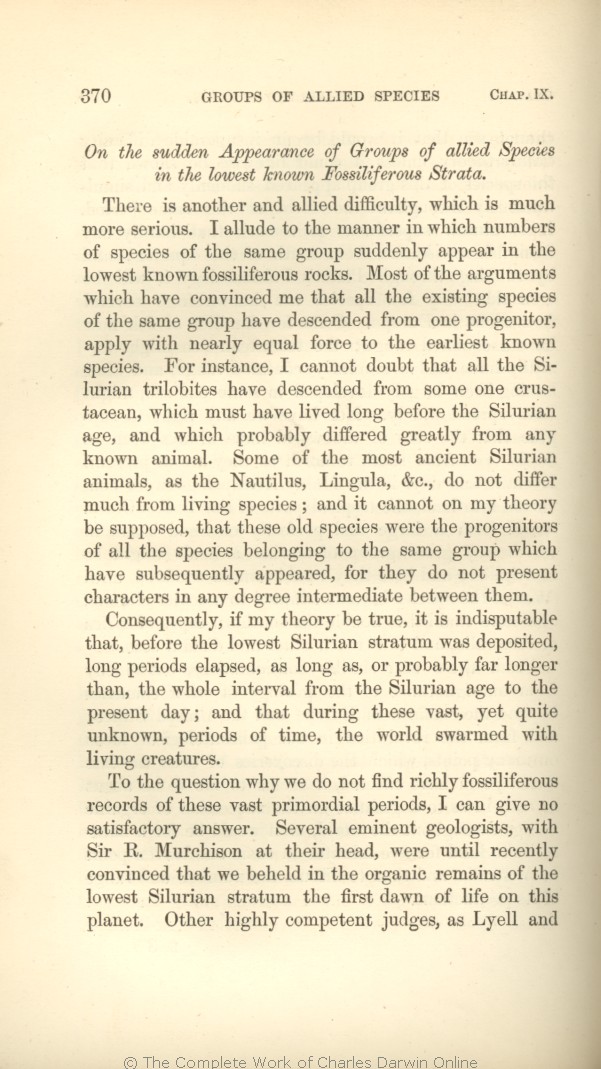On
|
On
1866 1869 1872 | |
On
1859 1860 1861 |
|
the
1866 1869 1872 | |
the
1859 1860 1861 |
|
sudden
1866 1869 1872 | |
sudden
1859 1860 1861 |
|
Appearance
1866 1869 1872 | |
appearance
1859 1860 1861 |
|
of
1866 1869 1872 | |
of
1859 1860 1861 |
|
Groups
1866 1869 1872 | |
groups
1859 1860 1861 |
|
of
1866 1869 1872 | |
of
1859 1860 1861 |
|
allied
1866 1869 1872 | |
Allied
1859 1860 | |
allied
1861 |
|
Species
1866 1869 1872 | |
Species
1859 1860 1861 |
|
in
1866 1869 1872 | |
in
1859 1860 1861 |
|
the
1866 1869 1872 | |
the
1859 1860 1861 |
|
lowest
1866 1869 1872 | |
lowest
1859 1860 1861 |
|
known
1866 1869 1872 | |
known
1859 1860 1861 |
|
Fossiliferous
1866 1869 1872 | |
fossiliferous
1859 1860 1861 |
|
Strata
. 1866 1869 1872 | |
strata
.—
1859 1860 1861 |
|
There is another and allied difficulty, which is much
more serious. | more serious. 1866 1869 1872 | | graver. 1859 1860 1861 |
| numbers of species 1859 1860 1861 1866 |
| many species in several 1869 |
| species belonging to several 1872 |
| same group 1866 |
| same group, 1859 1860 1861 |
| main divisions of the animal kingdom 1869 1872 |
| have 1859 1860 1861 1866 | | are 1869 1872 |
| one 1859 1860 1861 1866 | | a single 1869 1872 |
| nearly 1859 1860 1861 1866 1869 | nearly 1872 |
| I 1859 1860 1861 1866 | | it 1869 1872 |
| doubt 1859 1860 1861 1866 | | be doubted 1869 1872 |
| Silurian trilobites have 1859 1860 1861 1866 |
| Silurian trilobites are 1869 |
| Cambrian and Silurian trilobites are 1872 |
| Silurian 1859 1860 1861 1866 1869 | | Cambrian 1872 |
| Silurian 1859 1860 1861 1866 1869 | Silurian 1872 |
| &c., 1859 1860 1866 1869 1872 | | &c, 1861 |
| my 1859 1860 1861 1866 | | our 1869 1872 |
| belonging to the same group which have subsequently appeared, 1866 |
| of the orders to which they belong, 1859 1860 1861 |
| belonging to the same groups which have subsequently appeared, 1869 1872 |
| do 1859 1860 1861 1866 | | are 1869 1872 |
| present characters 1859 1860 1861 1866 | present characters 1869 1872 |
| between them. 1859 1860 1861 1866 | | in character. 1869 1872 |
| 1 blocks not present in 1866 1869 1872; present in 1859 1860 1861 | | If, moreover, they had been the progenitors of these orders, they would almost certainly have been long ago supplanted and exterminated by their numerous and improved descendants.
|
|
|
Consequently, if
my | my 1859 1860 1861 1866 | | the 1869 1872 |
| that, 1866 1869 | | that 1859 1860 1861 1872 |
| Silurian 1859 1860 1861 1866 1869 | | Cambrian 1872 |
| stratum 1859 1860 1861 1866 1872 |
| or Cambrian stratum 1869 |
| deposited, 1859 1860 1861 1866 1872 | | deposited 1869 |
| Silurian 1859 1860 1861 1866 | | Cambrian 1869 1872 |
| vast, 1859 1860 1861 1866 | | vast 1869 1872 |
| yet quite unknown, periods of time, 1859 1860 1861 1866 |
| periods 1869 1872 |
|
|
To the question why we do not find
richly fossiliferous records of these vast primordial periods, | richly fossiliferous records of these vast primordial periods, 1866 |
| records of these vast primordial periods, 1859 1860 1861 |
| rich fossiliferous deposits belonging to these assumed earliest periods, 1869 |
| rich fossiliferous deposits belonging to these assumed earliest periods prior to the Cambrian system, 1872 |
| OMIT 1866 1869 1872 |
| of the most 1859 1860 1861 |
| were until recently 1866 1869 1872 |
| are 1859 1860 1861 |
| beheld 1866 1869 1872 | | see 1859 1860 1861 |
| first dawn 1866 1869 1872 | | dawn 1859 1860 1861 |
| life 1859 1860 1861 1866 | | life. 1869 1872 |
| on 1859 1860 1861 1866 | on 1869 1872 |
| this 1859 1860 1861 1866 | this 1869 1872 |
| planet. 1859 1860 1861 1866 | planet. 1869 1872 |
|









